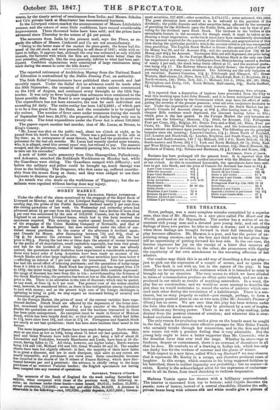Madame Vestris opens her theatre with a brilliancy unprecedented. The
interior is renovated from top to bottom; solid Cupids decorate the panels; rows of lustres, instead of a central chandelier, illumine the sale; private boxes hung with crimson silk and white muslin give a picture of
luxury and magnificence; the choice of colours (light blue, light pink, Ond white) prevents splendour from running into heaviness. Nothing more elaborately superb than the interior of the Lyceum is to be seen in London.
But Madame Vestris must take care not to rely too much on the de- corative attractions of her house. The elegance of the plate will not ren- der the guest totally indifferent to the quality of the dinner. The novel- ties with which she has opened are certainly not of the best. The first, The Pride of the Market—a tale of a market-girl who is carried off by a Mar- quis, and who having the power to put him into the Bastile as a punish- ment for this offence, uses her power to make him consent to a marriage of his sister, which he had previously opposed—is a great deal too long for its subject, and appears written with a deliberate aim at diffuseness. How- ever, Madame Vestris gives it a stamp by taking the character of the mar- ket-girl; and Buckstone creates laughter by his extravagant jealousy in the part of a plebeian lover; and it may be pronounced successful. The other piece, The Light Dragoons—in which Mr. Charles Matthews plays a flippant military gentleman, who consents to the strange expedient of mar- rying an ugly old lady, that be may induce her to bestow her niece on his friend—is a failure. It ought to have been a mere interlude, and yet it is extended to two acts. What a frightful propensity for length seems to pre- vail now-a-daysl—at the Haymarket, five acts when there ought to have been two; at the Lyceum, two when there ought to have been one. The golden truth, that conciseness, not diffuseness, should be the goal of the dra- matist, seems to be fearfully forgotten.

























 Previous page
Previous page